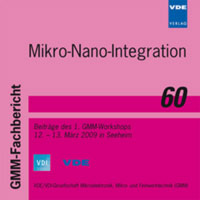Nano-Technologies for Heterogeneous System Integration
Konferenz: Mikro-Nano-Integration - 1. GMM-Workshops
12.03.2009 - 13.03.2009 in Seeheim, Germany
Tagungsband: Mikro-Nano-Integration
Seiten: 6Sprache: EnglischTyp: PDF
Persönliche VDE-Mitglieder erhalten auf diesen Artikel 10% Rabatt
Autoren:
Braun, T.; Becker, K.-F.; Bauer, J.; Jung, E.; Koch, M.; Bader, V.; Minge, C.; Aschenbrenner, R. (Fraunhofer Institute for Reliability and Microintegration, Gustav-Meyer-Allee 25, 13355 Berlin, Germany)
Reichl, H. (Technical University Berlin, Microperipheric Center, Berlin, Germany)
Inhalt:
As the development of microelectronics is still driving towards further miniaturization new materials, processes and technologies are crucial for the realization of future cost effective microsystems and components. These future systems will not only consist of SMDs and ICs assembled on a substrate, but will potentially integrate also living cells, organelles, nanocrystals, tubules and other tiny things forming a true Heterogeneous System. Future ICs and passives will also decrease in size, e.g. for RF-ID applications forecast die sizes are smaller than 250 µm, thicknesses less than 50 µm and pitches way below 100 µm, passives, if not directly integrated into the system carrier, will be even smaller. New placement and joining technologies are demanded for reliable and low cost assembly of such applications, as today’s packaging technologies only allow the assembly of those small dies and components with a very high effort and for this reason with high cost. With ongoing miniaturization also the protection of the microsystems mostly realized by a polymer needs to be decreased in thickness, yet providing maximum protection. Here, besides mechanical stability, humidity barrier functionality is a key factor for system reliability. Fraunhofer IZMs approaches towards packaging technologies facing the demands of future nano-based Hetero System Integration are described within this paper, comprising material and process development. Material developments focus on nano-particle enhanced polymers. One example are materials with optimized humidity barrier functionality, where various filler particles are integrated into a microelectronic grade epoxy resin and investigated regarding their barrier properties. Process development comprises touchless handling concepts that are promising for handling miniaturized components, not directly fabricated at the very place where they are needed. Different concepts are under evaluation. Magnetic handling can be regarded as one of the most ripened ones, thanks to the rugged approach explored. Another promising concept is the use of microdroplet manipulation by electrowetting. Results from both concept evaluations are presented and embedded into state-of-the-art process flows. In summary an overview on nano-based technologies – comprising results from the projects NanoSave, NanoMag and NanoMoist - well suited for heterogeneous system integration is given.


